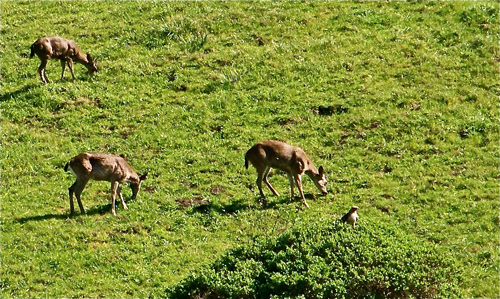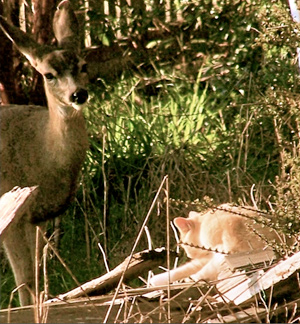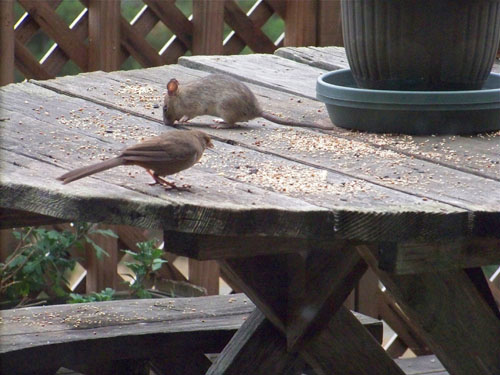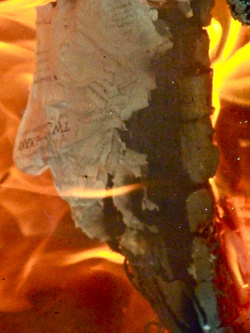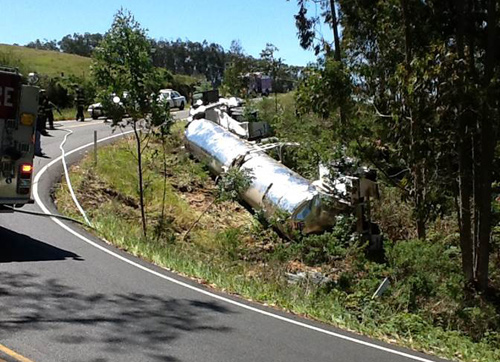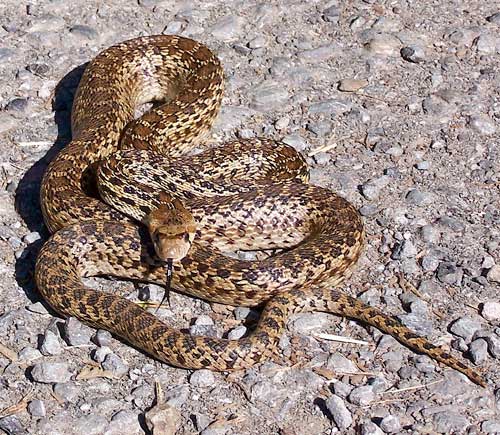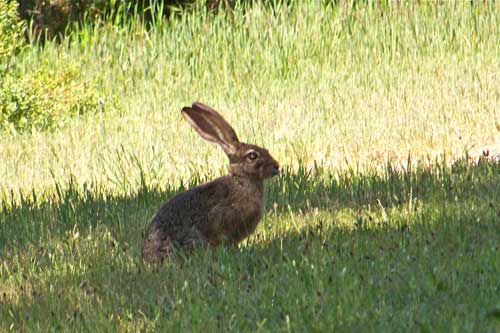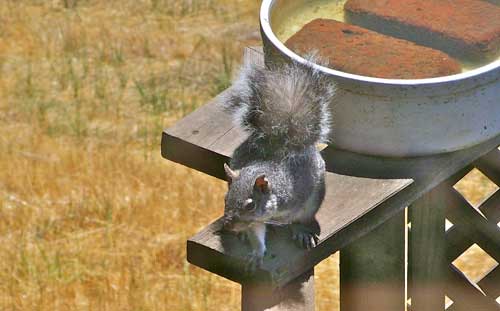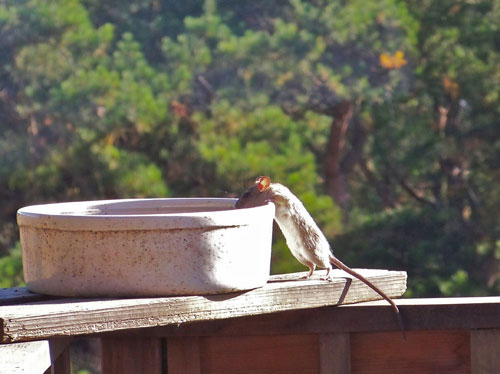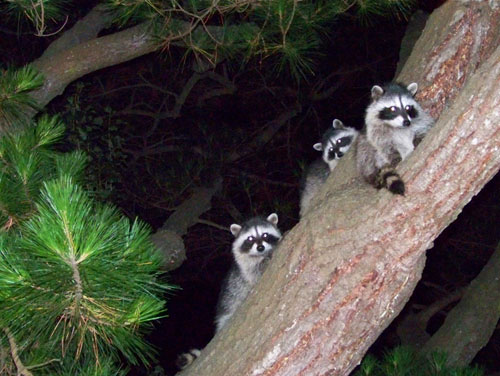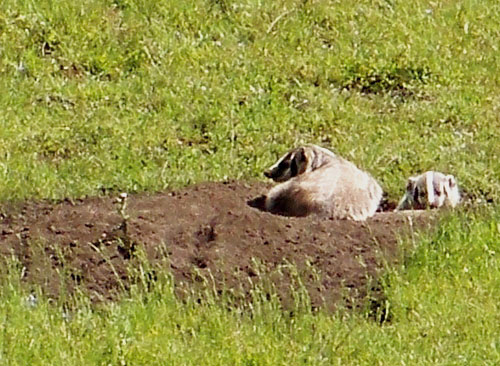Entries tagged with “roof rat”.
Did you find what you wanted?
Wed 15 Jun 2022
Posted by DavidMitchell under History, Photography, Point Reyes Station, West Marin nature, Wildlife
Comments Off on Natural coexistence
Caveat lectorem: When readers submit comments, they are asked if they want to receive an email alert with a link to new postings on this blog. A number of people have said they do. Thank you. The link is created the moment a posting goes online. Readers who find their way here through that link can see an updated version by simply clicking on the headline above the posting.
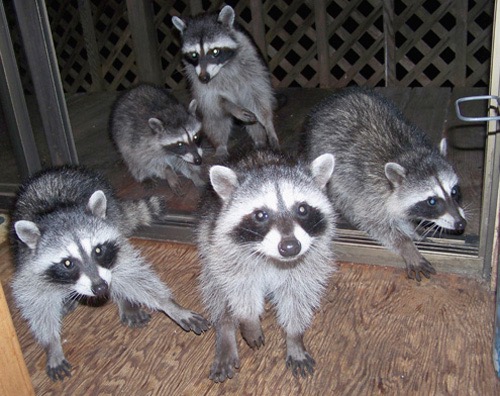
A family of raccoons enters the kitchen of Mitchell cabin in search of food. They were given some bread, but not in the kitchen.
Living in West Marin means living with nature. The surprise is how often nature manages to live with itself.

A blacktail buck and a bobcat foraging near each other on the hillside above Mitchell cabin. Each was aware of the other but didn’t seem to care.

A possum, fox, and raccoon eat kibble nose to nose just outside our kitchen door.
 Likewise dining side by side are this towhee and roof rat nibbling birdseed off our picnic table.
Likewise dining side by side are this towhee and roof rat nibbling birdseed off our picnic table.
 One surprising relationship went on for years around this part of town. This peacock was often seen in the company of a flock of wild turkeys. Unfortunately, I haven’t seen the peacock in recent months. I hope it’s okay. (Sad update: Obviously, not all species of wildlife are friendly toward each other, and the day after this posting went online, a neighbor told me a bobcat had killed the peacock.)
One surprising relationship went on for years around this part of town. This peacock was often seen in the company of a flock of wild turkeys. Unfortunately, I haven’t seen the peacock in recent months. I hope it’s okay. (Sad update: Obviously, not all species of wildlife are friendly toward each other, and the day after this posting went online, a neighbor told me a bobcat had killed the peacock.)
Just how close different species can live to each other was epitomized Tuesday evening. I had been lying on a couch in the living room listening to music when I got up and spotted a raccoon a few feet away eating kibble put out for our cat. The raccoon had managed to get inside because our kitchen door had been left open a few inches. It soon departed by the same route.
Sun 26 Apr 2015
Posted by DavidMitchell under General News, Marin County, West Marin nature, Wildlife
Comments Off on Birds, deer, a cat, a rat, a face in the flames, and another overturned truck
I’m always fascinated by how well some wildlife of different species get along with each other. Deer in particular seem to enjoy the company of other species.

I was reminded of this felicitous phenomenon when I spotted a hawk (lower right) keeping company with a small herd of deer grazing near Mitchell cabin. _____________________________________________________________
 A curious blacktail doe watches a house cat clean itself on a woodpile.
A curious blacktail doe watches a house cat clean itself on a woodpile.
I’ve also seen deer show similar interest in rabbits resting in my field.
_______________________________________________________

While another doe grazes, she keeps company with a great blue heron as the bird hunts gophers in my pasture.

A roof rat and a towhee eating birdseed side by side on our picnic table. It’s such a relaxed relationship that neither appears to notice the presence of the other. ________________________________________________________________
 Some things that happen around Mitchell cabin are more of a surprise.
Some things that happen around Mitchell cabin are more of a surprise.
Friday night I was lying on my side looking into my woodstove when I noticed a phantasmagorical head sticking out of the flames.
At first it appeared to be wrapped in newspaper headlines. Lynn, however, explained that she had used some discarded fundraising solicitation forms to light the fire.
____________________________________________________________

Yet another truck wreck in West Marin. A week ago Saturday, a truck and trailer rig hauling grocery supplies overturned on the Point Reyes-Petaluma Road, blocking traffic for nine hours.
Shortly before noon today, a milk truck overturned on Highway 1 near Nicks Cove, closing the highway for several hours. “The truck, heading south near Nicks Cove, failed to negotiate a turn and landed on its side along the highway,” said Mike Giannini, a battalion chief with Marin County Fire Department.
“The accident caused a hatch to fail and allow approximately 4,000 gallons of milk to be discharged from the tank. Additionally, about 100 gallons of diesel fuel was spilled. Firefighters were able to contain the diesel with absorbent materials.
“At the time of the accident, the milk was approximately 100 yards from Tomales Bay,” Giannini reported at 5 p.m. “Crews are continuing to monitor any possible threat to bay waters.
“The driver of the truck was evaluated by Marin County Fire Department paramedics and was transported to the hospital for evaluation. The exact cause of the accident is under investigation.”
All this is getting to be routine. Let’s see where next weekend’s truck wreck occurs.
Mon 5 Jan 2015
Posted by DavidMitchell under West Marin nature, Wildlife
Comments Off on A gallery of the critters around Mitchell cabin
 Around the first of the year I sometimes post a roundup of the creatures that have shown up around Mitchell cabin.
Around the first of the year I sometimes post a roundup of the creatures that have shown up around Mitchell cabin.
This year I’m doing it again, starting with a butterfly and dragonfly followed by a variety of larger critters.
This exhibit ends with a coyote, a bobcat, two badgers, and two deer rubbing noses.
Regular readers of this blog will recognize some of these photos from past postings.
Here a buckeye butterfly rests on a chrysanthemum that’s growing in a flowerpot on the deck. ___________________________________________________________________

A dragonfly pauses on the twig of a tree that’s next to the deck. Dragonflies can easily be distinguished from damselflies because when they are at rest they leave their wings extended while damselflies close their wings over their bodies when at rest. __________________________________________________________________
 A Pacific tree frog on a bamboo shoot near our hot tub.
A Pacific tree frog on a bamboo shoot near our hot tub.
Some people call them Pacific chorus frogs. During the winter, their main mating season, males make their way to water and then charm females to the water with a chorus of chirping.
________________________________________________________________

Gopher snakes are not poisonous, but they mimic rattlesnakes, coiling up and wagging their tongues when threatened. This one was near the foot of our driveway.

A jackrabbit in the field outside our kitchen window pauses to look around .

This is the only chipmunk I’ve ever seen around Mitchell cabin. I’m just glad I had my camera nearby when it showed up.

A Western gray squirrel basks in the sun after taking a drink from our birdbath.

A roof rat takes a drink from the birdbath. These rats originated in southern Asia, and you’ll recall it was their fleas that spread the Black Death throughout Europe in the 14th Century, killing roughly half the people.

This cute possum used to be a regular nighttime visitor, but so many raccoons have been hanging around the cabin in the evening that we seldom see any possums these days.

Three raccoons in a tree beside Mitchell cabin. ______________________________________________________________
 A gray fox enjoys the sun on our deck.
A gray fox enjoys the sun on our deck.
_________________________________________________________________

A coyote watches me park my car as I arrive back home.

A bobcat hunts outside our kitchen window.

A mother badger and her kit eye the world from their sett, as badger dens are called.

Two deer touch noses as a herd of six blacktails graze downhill from Mitchell cabin.
For reasons of space, no birds are included in this posting. Look for a gallery of our fine feathered friends in a week or two.
Tags: badgers, blacktail deer, bobcat, Buckeye butterfly, chipmunk, coyote, damselfly, dragonfly, gopher snake, gray fox, jackrabbit, Pacific tree frog, possum, raccoons, racoons, roof rat, Western gray squirrel
Mon 30 Jul 2012
Posted by DavidMitchell under West Marin nature, Wildlife
Comments Off on Wild scene from my deck as photographed over two weeks
Not all wildlife has fared as poorly as bears, wolves, and buffalo in the wake of the settlers spreading their brand of civilization across America. Indeed, the deck of Mitchell cabin bears testimony to how well other creatures have adapted to changed environs. Here’s a look at wildlife photographed on or from the deck during two weeks in July.

From the limbs of a pine tree, three young raccoons observe activity on the deck below. The raccoons around Mitchell cabin rarely ransack trash cans in search of garbage to eat. Ick! They instead supplement their foraging with nightly stops on the deck for rations of dog kibble.

For the past several weeks, mother raccoons have been introducing their new kits to the nightly repasts on my deck. That happens every summer. This year, however, the kits have taken to wrestling on the deck after dining. Here one kit struggles on its back after being tackled by a sibling.
It’s great fun to watch although the wrestling occasionally lasts well into the night, and it’s not unusual for Lynn and me to be awakened by the sound of outdoor furniture being knocked around. Worse yet is the damage they do to our flowers, as the rough-housing sometimes takes the kits into our planters. The youngster at left is sparring with a fourth kit that’s behind the planter barrel.

A young raccoon climbs down lattice in getting off the railing. Raccoons have the ability to twist their rear paws to point backwards. This greatly enhances their climbing because they can hang from their rear claws as they descend.

Red-winged blackbirds flock to the deck each evening when Lynn or I scatter birdseed on the railing and picnic table. By some estimates, the red-winged blackbird is the “most-abundant and best-studied bird in North America.”
Male redwings are all black except for a red bar and yellow patch on the shoulders while females are a nondescript dark brown.

Given his stately bearing, it’s appropriate that the California quail is the official state bird of California.

Pecking seeds. Here’s another look at the colorful head and tail of the male quail (at bottom). The female (at top) is less colorful but also has a crest. In between are two of their chicks. As with fawns, spots help camouflage young quail.

A march of quail chicks, with their mother (bottom left) keeping an eye out for trouble.

A rufus-sided towhee eats birdseed off the picnic table. The towhees breed from Canada to Guatemala and typically have two broods a year. The male helps feed the chicks, which fledge (can fly) in 10 to 12 days.

A White-tailed kite glides over my field while hunting for rodents. (They rarely eat birds.) Although the White-tailed kite was on the verge of extinction 75 years ago in California as a result of shooting and egg collecting, white-tails have now recovered to where their survival is no longer a concern to government ornithologists.

Two buzzards, taking advantage of fence posts on the east side of Mitchell cabin, warm themselves in the morning sun. What to call these birds, by the way, is hotly contested. For some, the only correct name is “vulture.”
The American Heritage Dictionary says a buzzard is “any of various North American vultures, such as the Turkey vulture.” A “chiefly British” meaning for the word buzzard, notes the dictionary, is “a hawk of the genus Buteo, having broad wings and a broad tail.”
The word can also refer to “an avaricious or otherwise unpleasant person,” the dictionary adds. For reasons that seem odd to me, ornithologists around West Marin seem to be chiefly British. Hey, this is Old West Marin, as the sign on the Old Western Saloon affirms. When a cowboy calls a bum “you old buzzard,” he means “you old carrion eater.” He certainly doesn’t mean you old “hawk [with] broad wings and a broad tail.”

A couple of roof rats visit the deck every evening to eat birdseed that the birds overlooked. Adult roof rats are 13 to 18 inches long, including their tails which are longer than their bodies.
They have been known to eat bird eggs, but they, in turn, are eaten by barn owls. As it happens, I saw one family of barn owls nesting at a neighbor’s house last week, so nature may still be in balance hereabouts.

The jackrabbit that this summer began hanging out around the hill sees me on the deck but remains motionless so as not to attract my attention.

A blacktail buck takes a rest next to the front steps a short distance from the deck. Although two of us took turns photographing him, he must have felt safe, for he stuck around.

The buck, in fact, seems fairly comfortable around people. Here he watches my neighbor Mary Huntsman gardening. She was unaware of his presence until I later showed her this photograph.

Almost every evening around 11 p.m., a gray fox shows up at the kitchen door, looking for bread. Lynn and I typically spend half an hour feeding him cheap, white bread one slice at a time.
Then he’ll disappear in search of more substantial fare. How do I know this? He leaves his seed-filled scat in prominent places around the property. The fox obviously has great balance, for he even leaves deposits on top of fence posts. I don’t know whether to be disgusted or impressed.

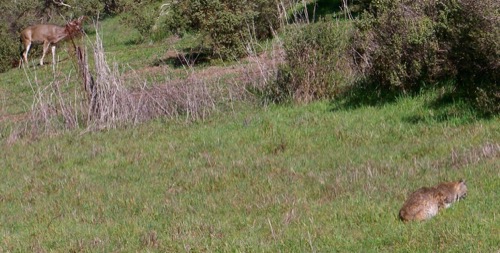
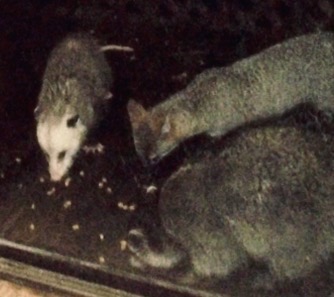
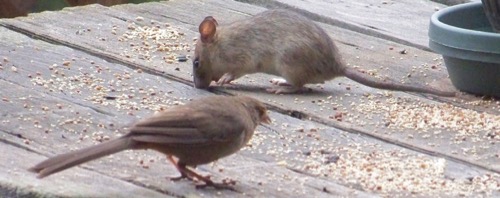 Likewise dining side by side are this towhee and roof rat nibbling birdseed off our picnic table.
Likewise dining side by side are this towhee and roof rat nibbling birdseed off our picnic table.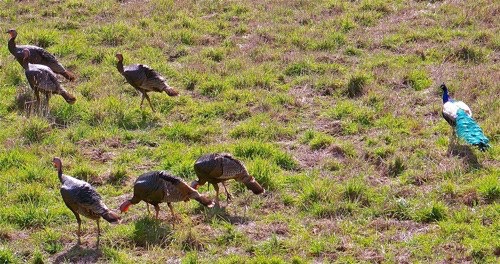 One surprising relationship went on for years around this part of town. This peacock was often seen in the company of a flock of wild turkeys. Unfortunately, I haven’t seen the peacock in recent months. I hope it’s okay. (Sad update: Obviously, not all species of wildlife are friendly toward each other, and the day after this posting went online, a neighbor told me a bobcat had killed the peacock.)
One surprising relationship went on for years around this part of town. This peacock was often seen in the company of a flock of wild turkeys. Unfortunately, I haven’t seen the peacock in recent months. I hope it’s okay. (Sad update: Obviously, not all species of wildlife are friendly toward each other, and the day after this posting went online, a neighbor told me a bobcat had killed the peacock.)
